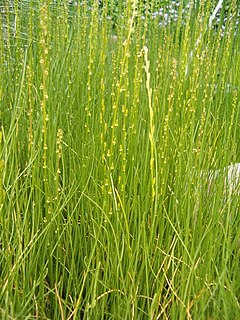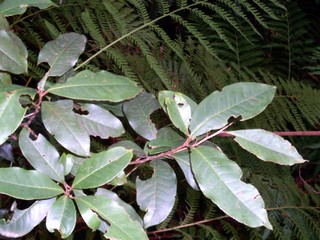
The Santalales are an order of flowering plants with a cosmopolitan distribution, but heavily concentrated in tropical and subtropical regions. It derives its name from its type genus Santalum (sandalwood). Mistletoe is the common name for a number of parasitic plants within the order.

Loranthaceae, commonly known as the showy mistletoes, is a family of flowering plants. It consists of about 75 genera and 1,000 species of woody plants, many of them hemiparasites. The three terrestrial species are Nuytsia floribunda, Atkinsonia ligustrina, and Gaiadendron punctatum Loranthaceae are primarily xylem parasites, but their haustoria may sometimes tap the phloem, while Tristerix aphyllus is almost holoparasitic. For a more complete description of the Australian Loranthaceae, see Flora of Australia online., for the Malesian Loranthaceae see Flora of Malesia.

Juncaginaceae is a family of flowering plants, recognized by most taxonomists for the past few decades. It is also known as the arrowgrass family. It includes 3 genera with a total of 34 known species.

Olacaceae is a family of flowering plants in the order Santalales. They are woody plants, native throughout the tropical regions of the world. As of July 2021, the circumscription of the family varies; some sources maintain a broad family, others split it into seven segregate families.
Octoknemaceae is a monotypic family of flowering plants endemic to continental Africa. The APG III system of 2009 and the APG II system of 2003, do not recognize this family. The family is recognized by the Angiosperm Phylogeny Website, based on work since the publication of the APG III system.

Schoepfiaceae is a family of flowering plants recognized in the APG III system of 2009. The family was previously only recognized by few taxonomists; the plants in question usually being assigned to family Olacaceae and Santalaceae.

Misodendrum is a genus of hemiparasites which grow as mistletoes on various species of Nothofagus. Its species are all restricted to South America. The name of the genus is incorrectly spelt in a number of ways, including Misodendron and Myzodendron.

Opiliaceae is a family of flowering plants comprising 11 genera and 33 known species. It consists of tropical woody plants. Several genera contain parasitic species. The biggest genus, in number of species and in stature of the individual plants, is Agonandra, the only American genus.

The Balanophoraceae are a subtropical to tropical family of obligate parasitic flowering plants, notable for their unusual development and formerly obscure affinities. In the broadest circumscription, the family consists of 16 genera. Alternatively, three genera may be split off into the segregate family Mystropetalaceae.

Loasaceae is a family of 15–20 genera and about 200–260 species of flowering plants in the order Cornales, native to the Americas and Africa. Members of the family include annual, biennial and perennial herbaceous plants, and a few shrubs and small trees. Members of the subfamily Loasoideae are known to exhibit rapid thigmonastic stamen movement when pollinators are present.

The Icacinaceae are a family of flowering plants, consisting of trees, shrubs, and lianas, primarily of the tropics.

Anacolosa is a plant genus of 15 to 22 species. In the APG IV system, the genus is placed in the family Olacaceae. Other sources place it in the segregate family Aptandraceae. The generic name is from the Greek anakolos, meaning "knotted", referring to the calyx cup rim.
Ochanostachys is a genus of flowering plants with a single species, Ochanostachys amentacea. The genus is placed in the family Olacaceae in the APG IV system and by sources that use it. It may alternatively be placed in the family Coulaceae, if the split of Olacaceae into seven separate families is accepted. Ochanostachys amentacea is native to the Andaman Islands, Borneo, Peninsular Malaysia, the Nicobar Islands, Sumatra and Thailand.

The Paracryphiaceae are a family of woody shrubs and trees native to Australia, southeast Asia, and New Caledonia. In the APG III system of 2009, the family is placed in its own order, Paracryphiales, in the campanulid clade of the asterids. In the earlier APG II system, the family was unplaced as to order and included only Paracryphia.
Hondurodendron is a monotypic genus of tree endemic to Honduras. The only species in the genus, H. urceolatum, was discovered during 2004 and 2006 botanical surveys of plants in Parque Nacional El Cusuco in northwest Honduras. It was subsequently described in 2010 by Carmen Ulloa Ulloa, Daniel L. Nickrent, Caroline Whitefoord, and Daniel L. Kelly in the Annals of the Missouri Botanical Garden.
Aptandra is a genus of flowering plants. In the APG IV system, the genus is placed in the family Olacaceae. Other sources place it in the segregate family Aptandraceae.
Chaunochiton is a genus of flowering plants. In the APG IV system, the genus is placed in the family Olacaceae. Other sources place it in the segregate family Aptandraceae.

Harmandia mekongensis is a species of flowering plants. It is the only species in the monotypic genus of Harmandia. In the APG IV system, the genus is placed in the family Olacaceae. Other sources place it in the segregate family Aptandraceae.
Ongokea is a genus of flowering plants, with one species Ongokea gore. In the APG IV system, the genus is placed in the family Olacaceae. Other sources place it in the segregate family Aptandraceae.
Phanerodiscus is a genus of flowering plants. In the APG IV system, the genus is placed in the family Olacaceae. Other sources place it in the segregate family Aptandraceae.












